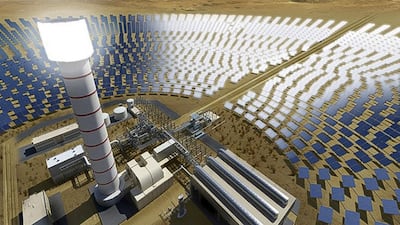Falling costs in the concentrated solar power (CSP) sector is likely to accelerate projects deploying the technology in markets with high solar irradiation such as the UAE and Oman, according to a report by BMI.
CSP differs from photovoltaic (PV) technology in that the energy it produces can be more easily stored but PV has historically been cheaper and easier to use.
"The technology's ability to store power via thermal transfer will lead to a notable uptick in project deployment in the Americas and Middle East and Northern Africa (Mena) regions - aided substantially by the cost-deflation registered over the last few years," BMI said.
"Ultimately, falling costs will ensure that many projects in the preliminary stages of development will progress and that the technology becomes increasingly interesting to governments and developers in new markets over the coming decade," the research firm said in its latest report.
CSP solar capacity currently makes up only eight per cent of total capacity collated, while PV solar power dominates the market due to its easy deployment, particularly for small and large-scale projects. Unlike CSP, PV technology is not reliant on direct irradiation, which makes it more effective in converting diffuse radiation into electricity.
Falling prices for CSP have led to its gradual uptake in mega-projects in the Middle East. In September, Dubai launched the world's largest CSP plant - a 700MW extension to the existing Mohammed bin Rashid al-Maktoum Solar complex, which is set to provide more than three times the capacity initially planned.
The developers - a consortium of Saudi Arabia's Acwa Power and China's Shanghai Power - also submitted low bids to generate electricity at 7.3 US cents per kilowatt-hour (kWh).
"This [project] points to a substantial cost deflation from the first three stages of Morocco's Noor CSP facility - which entered power purchase agreements worth US$140/MWh [14 cents per kWh] or more between 2012 and 2015," BMI said in its note.
The falling cost of developing CSP projects has put an upbeat outlook on those already in the pre-construction stage and BMI expects several of these to progress over the coming few years as governments and developers capitalise on the changing economics in the segment and actively look to implement new projects that have electricity storage capacity. CSP will also become more attractive in markets where the technology would typically be priced out by PV but have good potential for direct solar irradiation.
“This will be particularly relevant in the Mena and Americas regions in the near-term, but we expect CSP's geographical footprint to diversify into new markets that have high direct solar irradiation potential over the coming years," the report added.


